A plaque on the front of this Wetherspoon pub recalls that a famous coaching inn, called The Crosse Keys, stood near this site.
A framed collection of photographs, illustrations and text about The Crosse Keys.
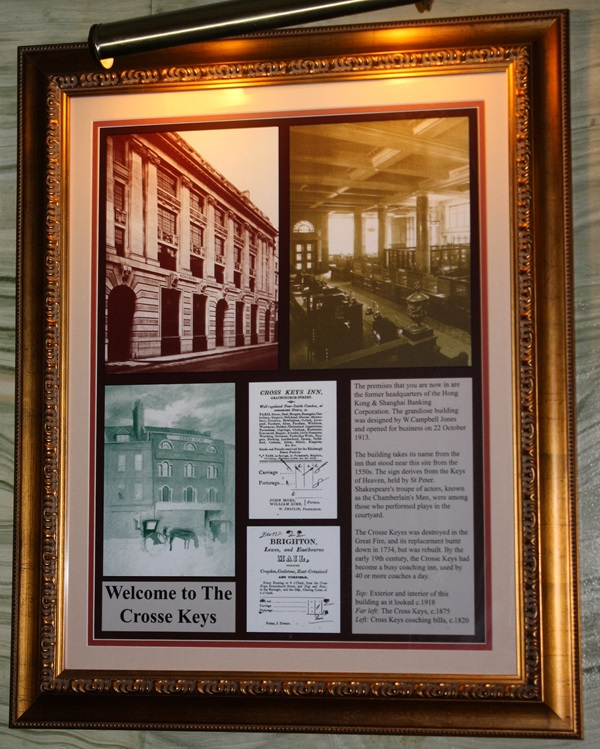
The text reads: The premises that you are now in are the former headquarters of the Hong Kong & Shanghai Banking Corporation. The grandiose building was designed by W. Campbell Jones and opened for business on 22 October 1913.
The building takes its name from the inn that stood near this site from the 1550s. The sign derives from the Keys of Heaven, held by St Peter.
Shakespeare’s troupe of actors, known as the Chamberlain’s Men, were among those who performed plays in the courtyard.
The Crosse Keyes was destroyed in the Great Fire, and its replacement burnt down in 1734, but was rebuilt. By the early 19th century, the Crosse Keys had become a busy coaching inn, used by 40 or more coaches a day.
Top: Exterior and interior of this building as it looked c.1918
Far left: The Crosse keys, c.1875
Left: Cross Keys coaching bills, c.1820
A framed collection of illustrations and text about Leadenhall Market.
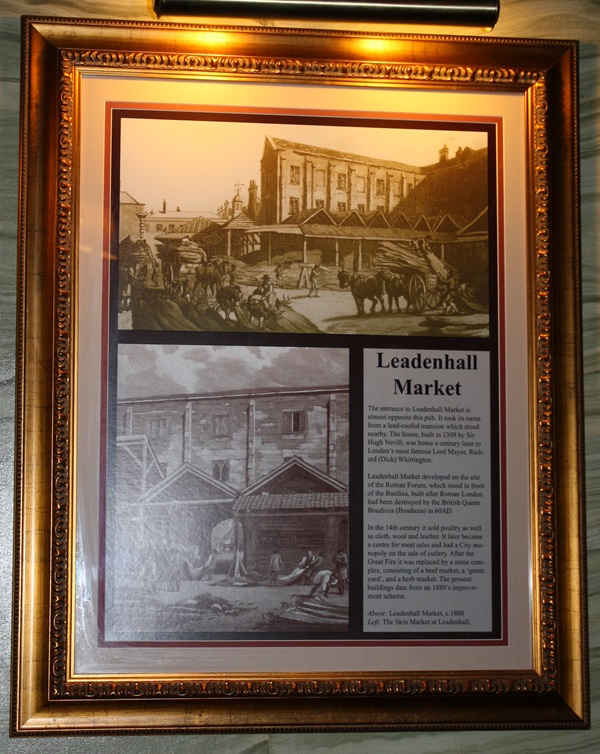
The text reads: The entrance to Leadenhall Market is almost opposite this pub. It took its name from a lead-roofed mansion which stood nearby. The house, built in 1309 by Sir Hugh Nevill, was home a century later to London’s most famous Lord Mayor, Richard (Dick) Wittington.
Leadenhall Market developed on the site of the Roman forum, which stood in front of the Roman Forum, which stood in front of the Basilica, built after Roman London had been destroyed by the British Queen Boudicca (Boadicea) in 60AD.
In the 14th century it sold poultry as well as cloth, wool and leather. It later became a centre for meat sales and had a City monopoly on the sale of cutlery. After the Great Fire it was replaced by a stone complex, consisting of a beef market, a ‘green yard’, and a herb market. The present buildings date from an 1880’s improvement scheme.
Above: Leadenhall Market, c.1808
Left: The Skin market at Leadenhall.
Framed illustrations and text about Penny Universities.
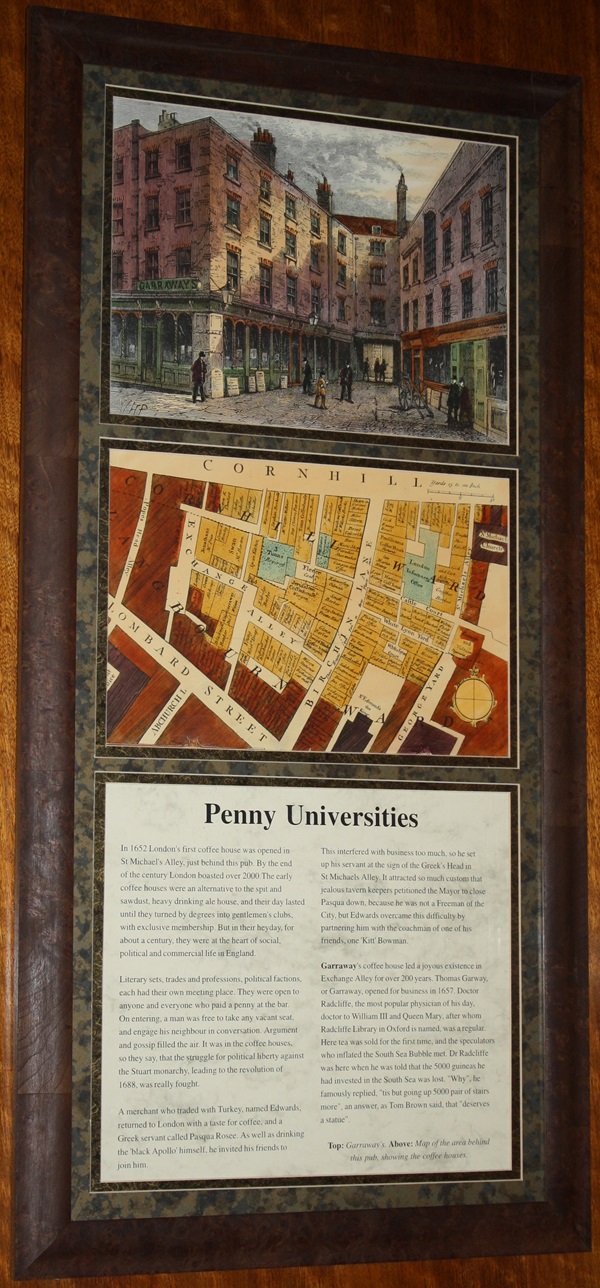
The text reads: In 1652 London’s first coffee house was opened in St Michael’s Alley, just behind this pub. By the end of the century London boasted over 2000. The early coffee houses were an alternative to the spit and sawdust, heavy drinking ale house, and their day lasted until they turned by degrees into gentlemen's clubs, with exclusive membership. But in their heyday, for about a century, they were at the heart of social, political and commercial life in England.
Literary sets, trades and professions, political factions, each had their own meeting place. They were open to anyone and everyone who paid a penny at the bar. On entering, a man was free to take any vacant seat, and engage his neighbour in conversation. Argument and gossip tilled the air. It was in the coffee houses, so they say, that the struggle for political liberty against the Stuart monarchy leading to the revolution of 1688, was really fought.
A merchant who traded with Turkey, named Edwards, returned to London with a taste for coffee, and a Greek servant called Pasqua Rosee. As well as drinking the ‘black Apollo’ himself, he invited his friends to join him.
This interfered with business too much, so he set up his servant at the sign of the Greek's Head in St Michaels Alley. It attracted so much custom that jealous tavern keepers petitioned the Mayor to close Pasqua down, because he was not a Freeman of the City, but Edwards overcame this difficulty by partnering him with the coachman of one of his friends, one ‘Kitt’ Bowman.
Garraway’s coffee house led a joyous existence in Exchange Alley for over 200 years. Thomas Garway, or Garraway, opened for business in 1657. Doctor Radcliffe, the most popular physician of his day, doctor to William III and Queen Mary, after whom Radcliffe Library in Oxford is named, was a regular. Here tea was sold for the first time, and the speculators who inflated the South Sea Bubble met. Dr Radcliffe was here when he was told that the 5000 guineas he had invested in the South Sea was lost. “Why”, he famously replied, “tis but going up 5000 pair of stairs more”, an answer, as Tom Brown said, that "deserves a statue”.
Top: Garraway’s
Above: Map of the area behind this pub, showing the coffee houses.
A framed collection of illustrations and text about literary connections.
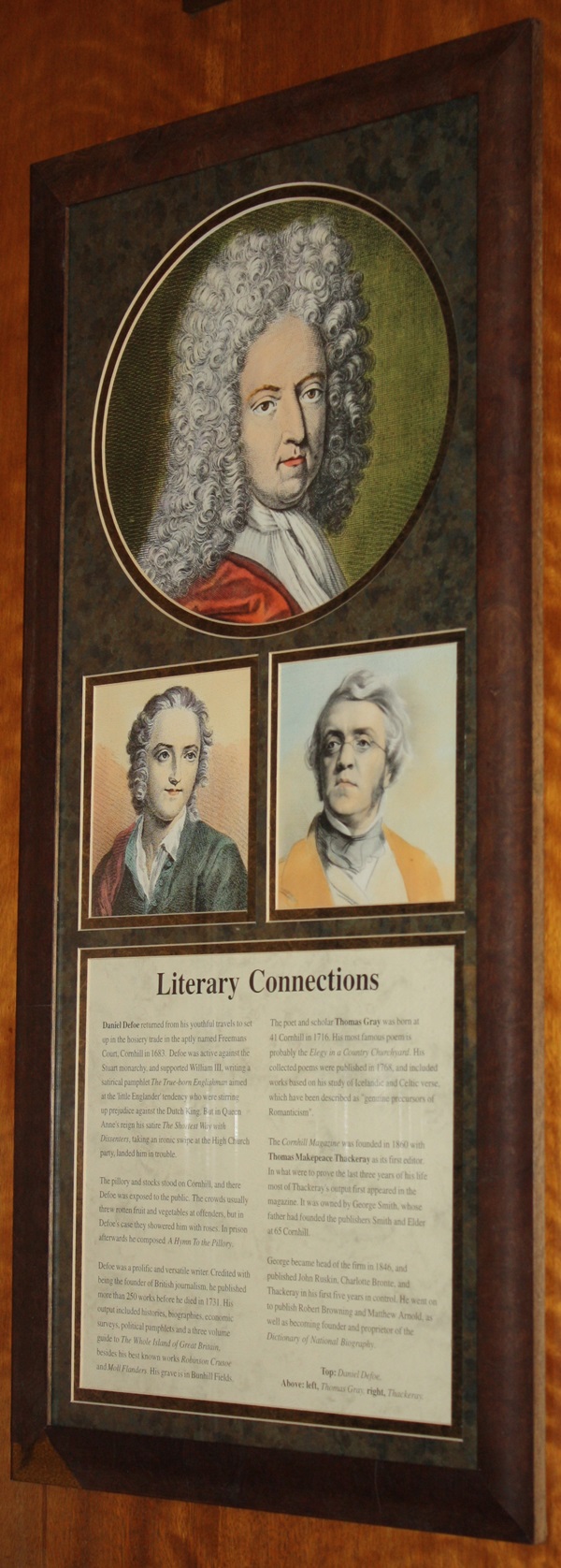
The text reads: Daniel Defoe returned from his youthful travels to set up in the hosiery trade in the aptly named Freemans Court, Cornhill in 1683. Defoe was active against the Stuart monarchy, and supported William III, writing a satirical pamphlet The True-Born Englishman aimed at the ‘little Englander’ tendency who were stirring up prejudice against the Dutch king. But in Queen Anne’s reign his Satire The Shortest Way with Dissenters, taking an ironic swipe at the High Church party, landed him in trouble.
The pillory and stocks stood on Cornhill, and there Defoe was exposed to the public. The crowds usually threw rotten fruit and vegetables at offenders, but in Defoe’s case they showered him with roses. In prison afterwards he composed A Hymn To the Pillory.
Defoe was a prolific and versatile writer. Credited with being the founder of British Journalism, he published more than 250 works before he died in 1731. His output included histories, biographies, economic surveys, political pamphlets and a three volume guide to The Whole Island of Great Britain, besides his best known works Robinson Crusoe and Moll Flanders. His grave is in Bunhill Fields.
The poet and scholar Thomas Gray was born at 41 Cornhill in 1716. His most famous poe, is probably the Elegy in a Country Churchyard. His collected poems were published in 1768, and included works based on his study of Icelandic and Celtic verse, which have been described as “genuine precursors of Romanticism”.
The Cornhill Magazine was founded in 1860 with Thomas Makepeace Thackeray as its first editor. In what were to prove the last three years of his life most of Thackeray’s output first appeared in the magazine. It was owned by George Smith, whose father had founded the publishers Smith and Elder at 65 Cornhill.
George became head of the firm in 1846, and published John Ruskin, Charlotte Bronte, and Thackeray in his first five years in control. He went on to publish Robert Browning and Matthew Arnold, as well as becoming founder and proprietor of the Dictionary of National Biography.
Top: Daniel Defoe
Above: left, Thomas Gray, right, Thackeray.
Framed illustrations and text about Grass Church Street (before the Great Fire).
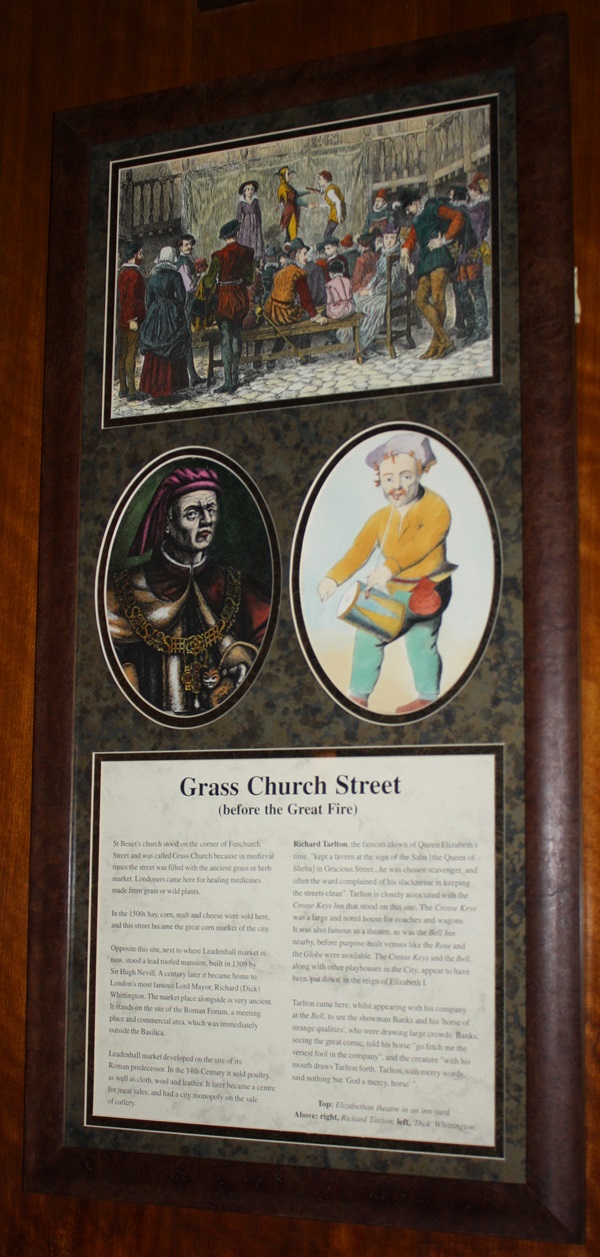
The text reads: St Benet’s church stood on the corner of Fenchurch Street and was called Grass Church because in medieval times the street was filled with the ancient grass or herb market. Londoners came here for healing medicines made from grass or wild plants.
In the 1500s hay, corn, malt and cheese were sold here, and this street became the great corn market of the city.
Opposite this site, next to where Leadenhall market is now, stood a lead roofed mansion, built in 1309 by Sir Hugh Nevill. A century later it became home to London’s most famous Lord Mayor, Richard (Dick) Whittington. The market place alongside is very ancient. It stands on the site of the Roman Forum, a meeting place and commercial area, which was immediately outside the Basilica.
Leadenhall market developed on the site of its Roman predecessor. In the 14th Century it sold poultry, as well as cloth, wool and leather. It later became a centre for meat sales, and had a city monopoly on the sale of cutlery.
Richard Tarlton, the famous clown of Queen Elizabeth’s time, “kept a tavern at the sign of the Saba [the Queen of Sheba] in Gracious Street…he was chosen scavenger, and often the ward complained of his slacknesse in keeping the streets clean”. Tarlton is closely associated with the Crosse Keys Inn that stood on this site. The Crosse Keys was a large and noted house for coaches and wagons. It was also famous as a theatre, was the Bell Inn nearby, before purpose-built venues like the Rose and the Globe were available. The Crosse Keys and the Bell, along with other playhouses in the City, appear to have been ‘put down’ in the reign of Elizabeth I.
Tarlton came here, whilst appearing with his company at the Bell, to see the showman Banks and his ‘horse of strange qualities’, who were drawing large crowds. Banks, seeing the great comic, told his horse “go fetch me the veriest fool in the company”, and the creature “with his mouth draws Tarlton forth. Tarlton, with merry words, said nothing but ‘God a mercy, horse’”.
Top: Elizabethan theatre in an inn yard
Above: right, Richard Tarlton, left, ‘Dick’ Whittington.
Framed illustrations and text about Sir Thomas Gresham.
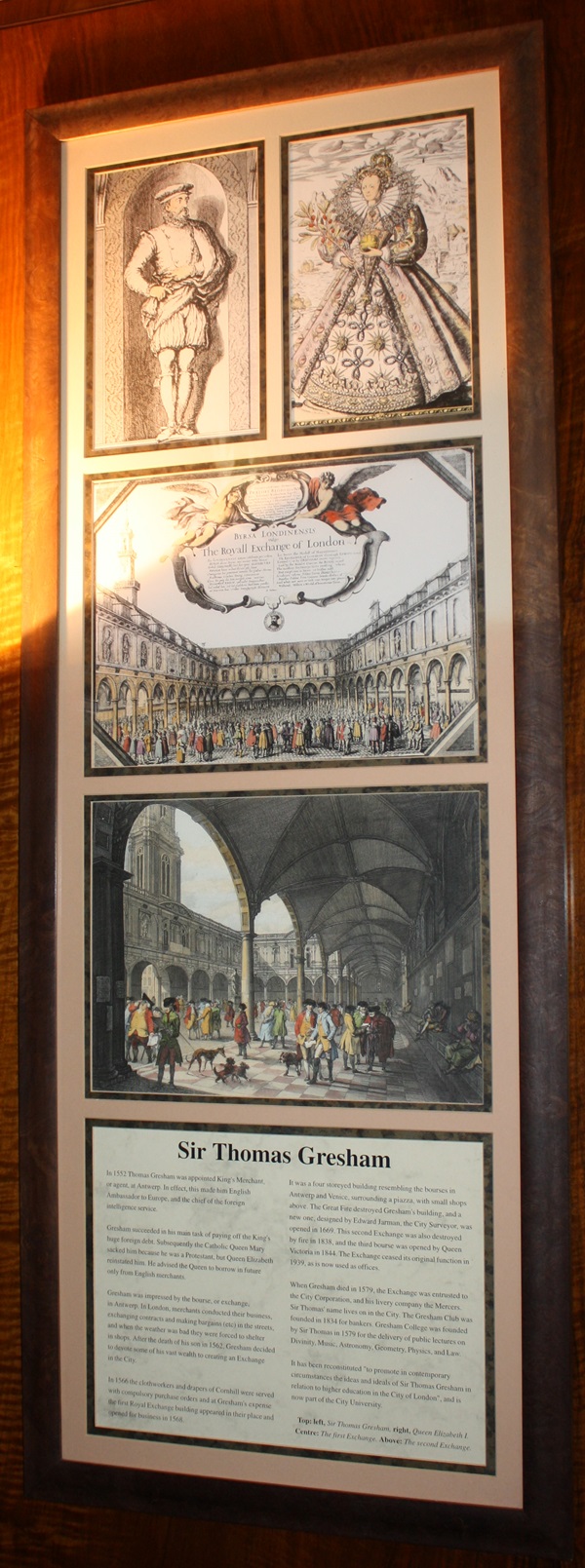
The text reads: In 1552 Thomas Gresham was appointed King’s Merchant, or agent, at Antwerp. In effect, this made him English Ambassador to Europe, and the chief of the foreign intelligence service.
Gresham succeeded in his main task of paying off the King’s huge foreign debt. Subsequently the Catholic Queen Mary sacked him because he was a protestant, but Queen Elizabeth reinstated him. He advised the Queen to borrow in future only from English merchants.
Gresham was impressed by the bourse, or exchange, in Antwerp. In London, merchants conducted their business, exchanging contracts and making bargains (etc) in the streets, and when the weather was bad they were forced to shelter in shops. After the death of his son in 1562, Gresham decided to devote some of his vast wealth to creating an Exchange in the City.
In 1566 the clothworkers and drapers of Cornhill were served with compulsory purchase orders and at Gresham’s expense the first Royal Exchange building appeared in their place and opened for business in 1568.
It was a four storeyed building resembling the bourses in Antwerp and Venice, surrounding a piazza, with small shops above. The Great Fire destroyed Gresham’s building, and a new one, designed by Edward Jarman, the City Surveyor, was opened in 1669. This second Exchange was also destroyed by fire in 1838, and the third bourse was opened by Queen Victoria in 1844. The Exchange ceased its original function in 1939, as is now used as offices.
When Gresham died in 1579, the Exchange was entrusted to the city Corporation and his livery company the Mercers. Sir Thomas’ name lives on in the City. The Gresham Club was founded in 1834 for bankers. Gresham College was founded by Sir Thomas in 1579 for the delivery of public lectures on Divinity, Music, Astronomy, Geometry, Physics, and Law.
It has been reconstituted “to promote in contemporary circumstances the ideas and ideals of Sir Thomas Gresham in relation to higher education in the City of London”, and is now part of the City University.
Top: left, Sir Thomas Gresham, right, Queen Elizabeth I,
Centre: The first Exchange, Above: The second Exchange.
Framed prints and text about the Hong Kong and Shanghai Bank.
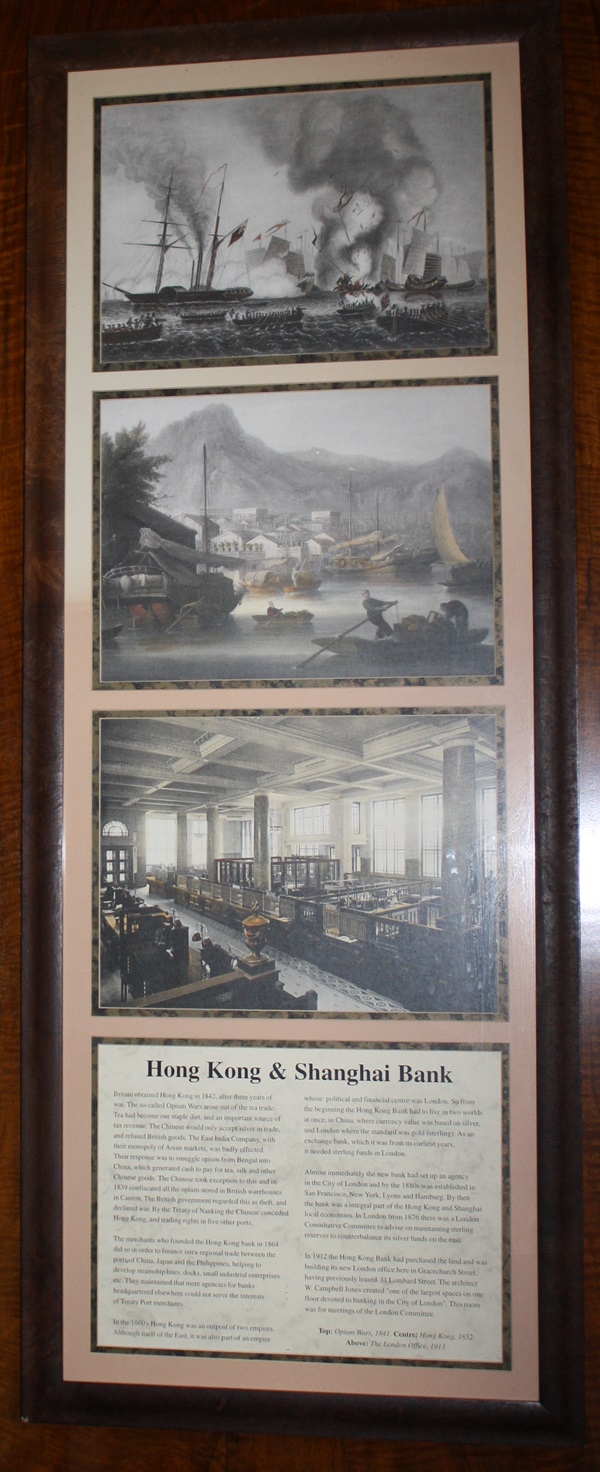
The text reads: Britain obtained Hong Kong in 1842, after three years of war. The so-called Opium Wars arose out of the tea trade. Tea had become our staple diet, and an important source of tax revenue. The Chinese would only accept silver in trade, and refused British goods. The East India Company, with their monopoly of Asian markets, was badly affected. Their response was to smuggle opium from Bengal into China, which generated cash to pay for tea, silk and other Chinese goods. The Chinese took exception to this and in 1839 confiscated all the opium stored in British warehouses in Canton. The British government regarded this as theft, and declared war. By the Treaty on Nanking the Chinese conceded Hong Kong, and trading rights in five other ports.
The merchants who founded the Hong Kong bank in 1864 did so in order to finance intra-regional trade between the ports of China, Japan and the Philippines, helping to develop steamship lines, docks, small industrial enterprises etc. They maintained that mere agencies for banks headquartered elsewhere could not serve the interests of Treaty Port merchants.
In the 1860’s Hong Kong was an outpost of two empires. Although itself of the East, it was also part of an empire whose political and financial centre was London. So from the beginning the Hong Kong Bank had to live in two world at once, in China, where currency value was based on silver, and London where the standard was gold (sterling). As an exchange bank, which it was from its earliest years, it needed sterling funds in London.
Almost immediately the new bank had set up an agency in the City of London and by the 1880s was established in San Francisco, New York, Lyons and Hamburg. By then the bank was a integral part of the Hong Kong and Shanghai local economies. In London from 1876 there was a London Consultative Committee to advise on maintaining sterling reserves to counterbalance its silver funds on the east.
In 1912 the Hong Kong Bank had purchased the land and was building its new London office here in Gracechurch Street, having previously leased 13 Lombard Street. The architect W.Campbell Jones created “one of the largest spaces on one floor devoted to banking in the City of London”. This room was for meeting of the London Committee.
Top Opium Wars, 1841 Centre: Hong Kong, 1852 Above: The London Office, 1913.
Framed prints and text about the stock exchange.

The text reads: Jonathan’s coffee house in Exchange alley was “the general mart for stock jobbers”. Stock brokers conducted business in and around the Royal Exchange. In 1694 the method of transacting business was described as follows: “The monied man goes among the brokers which are chiefly upon the Exchange and at Jonathan’s coffee houses and asks how stocks go and upon information bids the broker buy or sell so many shares of such and such stocks”. At this time the functions of a Broker (who buys and sells shares for a client), and a Jobber (who acts as a middle man between brokers and trades in shares on his own account) were combined.
In August 1722 the South Sea Bubble burst, and shares in the speculative venture that had stood at £1000 in June tumbled to £150 by August. Numerous people, some of them very eminent, were ruined. Two years later a group of respectable brokers formed themselves into a club and rented Jonathan’s coffee house for their exclusive use. In 1773 this group moved to a room in Sweetings Alley, which became known as the Stock Exchange Coffee House. Business boomed, so much so that in 1801 a group of members raised £20,000 and acquired a site in Capel Court, Bartholomew Lane, and had a new building purpose built. A larger exchange was opened in 1854, and another in 1888. The building on the site today was opened in 1972.
Some key events over the years have included installations of tickertape machines and then telephones in the 1870s; membership peaked in 1905 at 5.567; In 1908 it was made illegal to act both as a broker and a jobber; since 1971 new members have had to pass an examination in basic financial knowledge in 1973 women were admitted.
The use of the term Bull dates from 1714 and of Bear from 1709. Their origin is obscure, but Bear is possibly from the proverb “You must not sell the bear skin until you have shot the bear”.
A bear is defines as someone who first agrees to sell stock he does not possess, and then prowls the market looking for other people with property he can devour to meet his commitments. Bulls are defined as persons who buy stocks they have not got the money to pay for, and are consequently obliged to sell, either at a profit of a loss, before the contract falls due for payment.
Above: Jonathan’s Coffee House, 1763
Below: The Stock Exchange, c1890.
Framed prints and text about Lloyds.
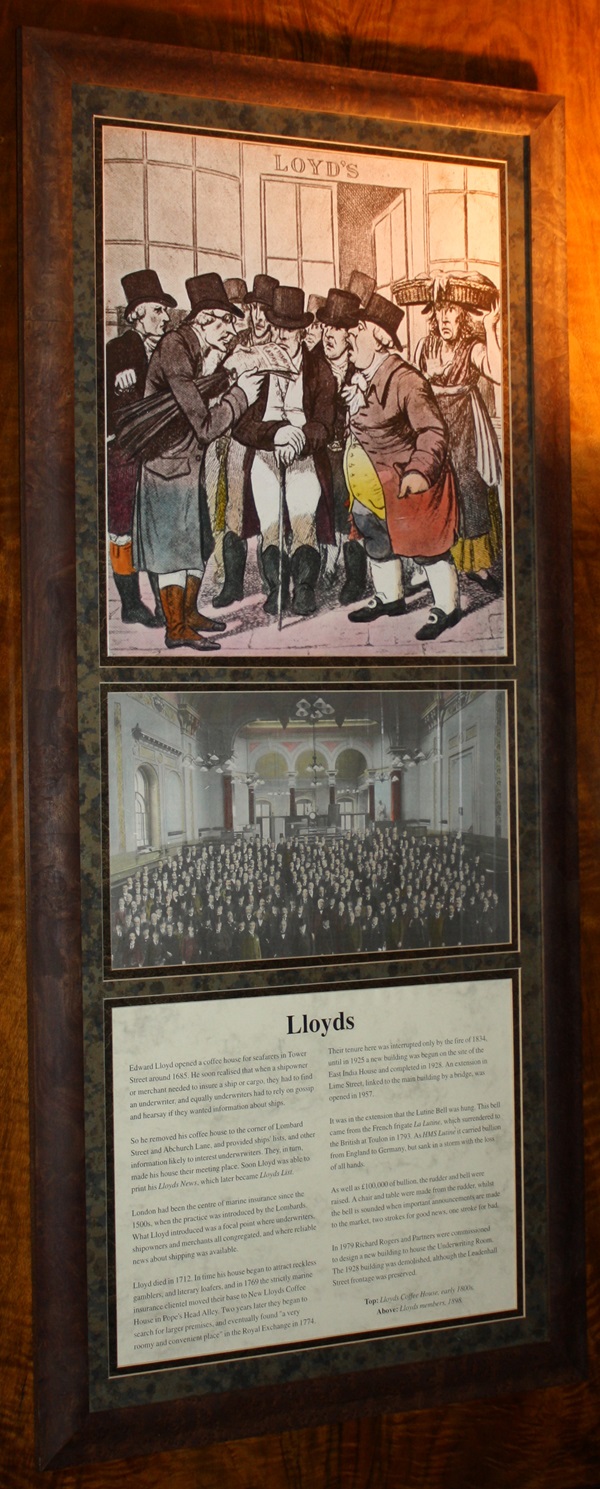
The text reads: Edward Lloyd opened a coffee house for seafarers in Tower Street around 1685. He soon realised that when a shipowner or merchant needed to insure a ship or cargo, they had to find an underwriter, and equally underwriters had to rely on gossip and hearsay if they wanted information about ships.
So he removed his coffee house to the corner of Lombard Street and Abchurch Lane, and provided ships’ lists, and other information likely to interest underwriters. They, in turn, made his house their meeting place. Soon Lloyd was able to print his Lloyds News, which later became Lloyds List.
London had been the centre of marine insurance since the 1500s, when the practice was introduced by the Lombards. What Lloyd introduced was a focal point where underwriters, shipowners and merchants all congregated, and where reliable news about shipping was available.
Lloyd died in 1712. In time his house began to attract reckless gamblers, and literary loafers, and in 1769 the strictly marine insurance clientel moved their base to New Lloyds Coffee House in Pope’s Head Alley. Two years later they began to search for larger premises, and eventually found “a very roomy and convenient place” in the Royal Exchange in 1774.
Their tenure was interrupted only by the fire of 1834, until in 1925 a new building was begun on the site of the East India House and completed in 1928. An extension in Lime Street, linked to the main building by a bridge, was opened in 1957.
It was in the extension that the Lutine Bell was hung. This bell came from the French frigate La Lutine, which surrendered to the British at Toulon in 1793. As HMS Lutine it carried bullion from England to Germany, but sank in a storm with the loss of all hands.
As well as £100,000 of bullion, the rudder and bell were raised. A chair and table were made from the rudder, whilst the bell is sounded when important announcements are made to the market, two strokes for good news, one stroke for bad.
In 1979 Richard Rogers and Partners were commissioned to design a new building to house the Underwriting Room. The 1928 building was demolished, although the Leadenhall Street frontage was preserved.
Top: Lloyds Coffee House, early 1800s
Above: Lloyds members, 1898.
A framed collection of illustrations and text about the City Livery Companies.
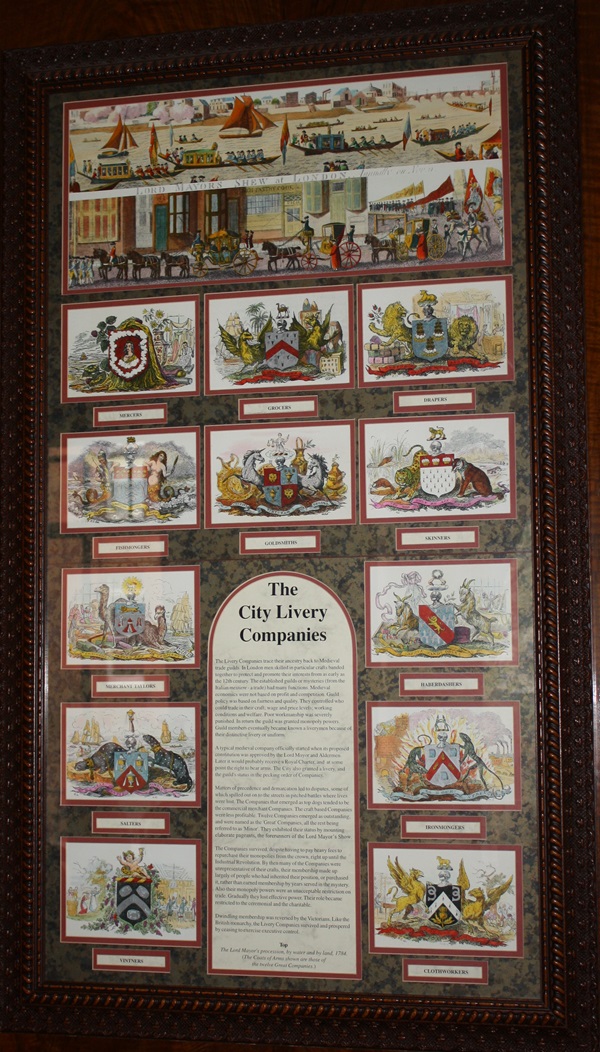
The text reads: The Livery Compaines trace their ancestry back to Medieval trade guilds. In London men skilled in particular crafts banded together to protect and promote their interests from as early as the 12th century. The established guilds or mysteries (from the Italian mestiere – a trade) had many functions. Medieval economics were not based on profit and competition, Guild policy was based on profit and competition. Guild policy was based on fairness and quality. They controlled who could trade in their craft; wage and price levels; working conditions and welfare. Poor workmanship was severely punished. In return the guild was granted monopoly powers. Guild members eventually became known as liverymen because of their distinctive livery or uniform.
A typical medieval company officially started when its proposed constitution was approved by the Lord Mayor and Aldermen. Later it would probably receive a Royal Charter, and at some point the right to bear arms. The City also granted a livery, and the guild’s status in the pecking order of Companies.
Matters of precedence and demarcation led to disputes, some of which spilled out on to the streets in pitched battles where lives were lost. The Companies that emerged as top dogs tended to be the commercial merchant companies. The craft based Companies were less profitable. Twelve Companies emerged as outstanding, and were named as the ‘Great’ Companies, all the rest being referred to as ‘Minor’. They exhibited their status by mounting elaborate pageants, the forerunners of the Lord Mayor’s Show.
The Companies survived, despite having to pay heavy fees to repurchase their monopolies from the crown, right up until the Industrial Revolution. By then many of the Companies were unrepresentative of their crafts, their membership made up largely of people who had inherited their position, or purchased it, rather than earned membership by years served in the mystery. Also their monopoly powers were an unacceptable restriction on trade. Gradually they lost effective power. Their role became restricted to the ceremonial and the charitable.
Dwindling membership was reversed by the Victorians. Like the British monarchy, the Livery Companies survived and prospered by ceasing to exercise executive control.
Top: The Lord Mayor’s procession, by water and by land, 1784. (The Coats of Arms shown are those of the twelve Great Companies.)
A framed portrait of Sir Thomas Gresham.
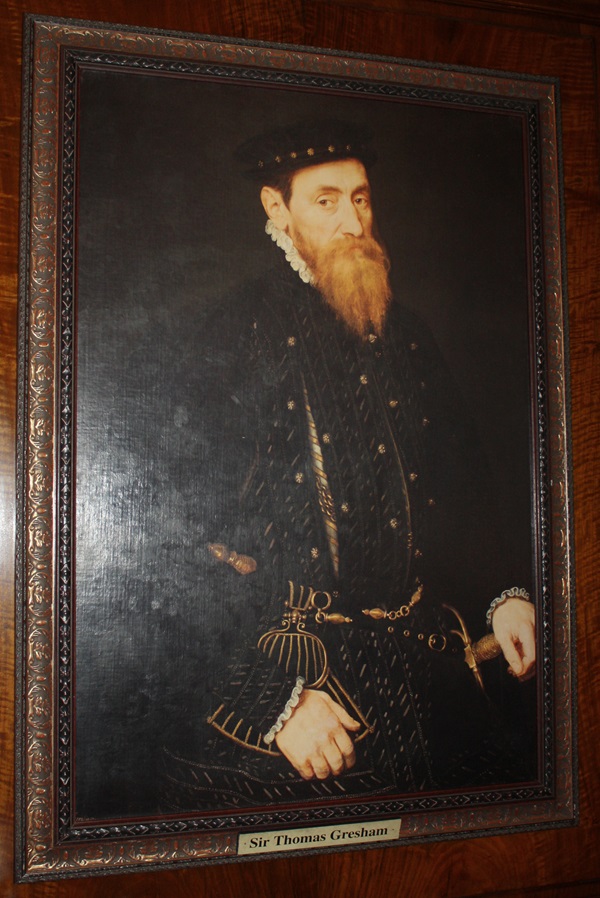
A framed map of the Cornhill area, before the Great Fire.
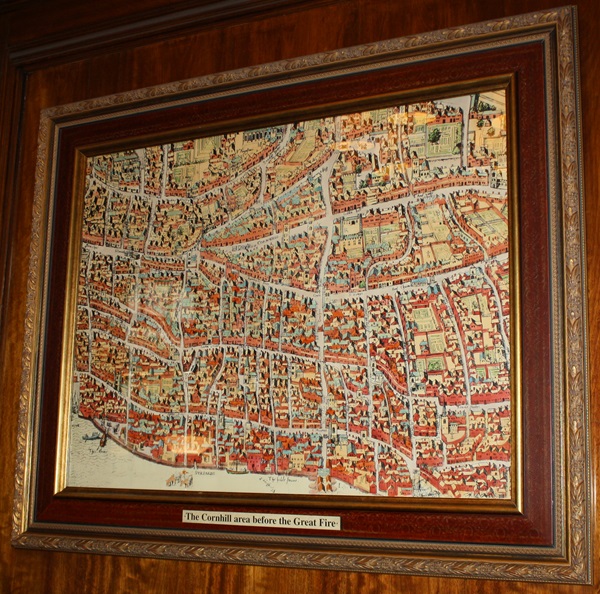
A framed illustration of Daniel Defoe in the stocks.
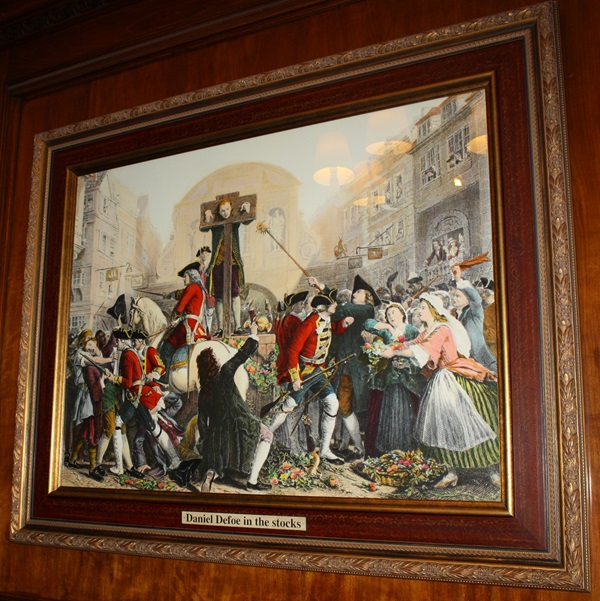
A view of the pub’s glass dome roof.
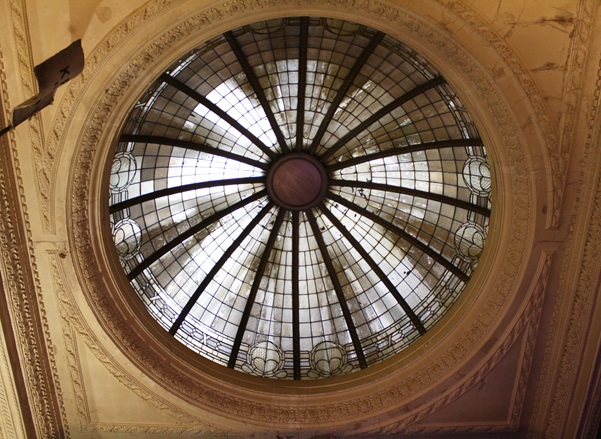
A wider view of the pub’s glass dome, directly above the stairwell.
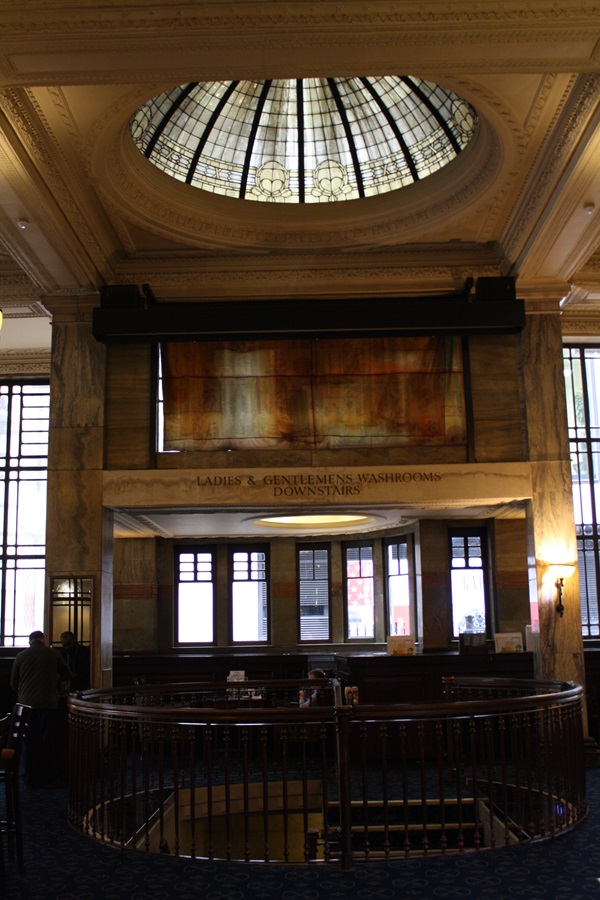
A view of the pub’s oval bar and some of the building’s marble pillars.
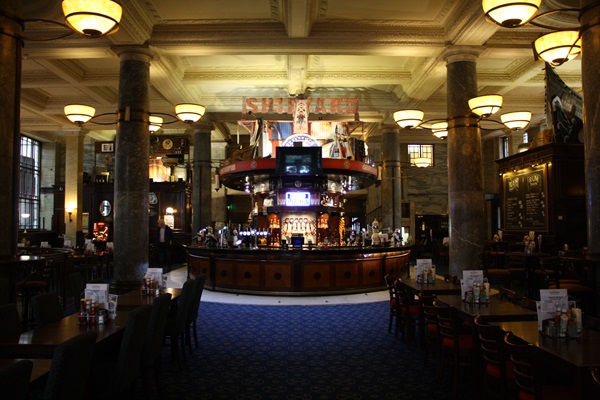
A view of one of the main dining areas, including the building’s marble fireplace.
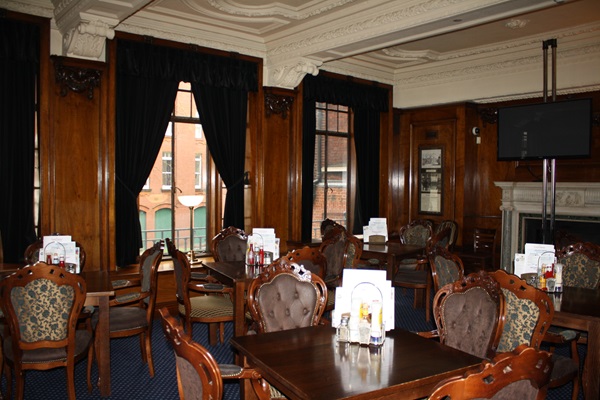
A plaque commemorating the site of the Crosskey’s Inn, destroyed in the Great Fire of London in 1666.
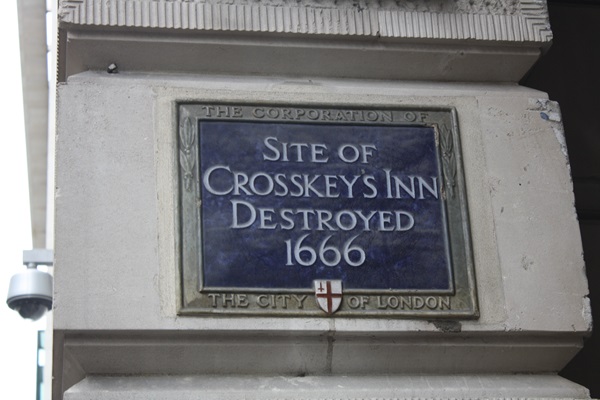
The rear entrance to the pub, located on St Michael’s Alley.
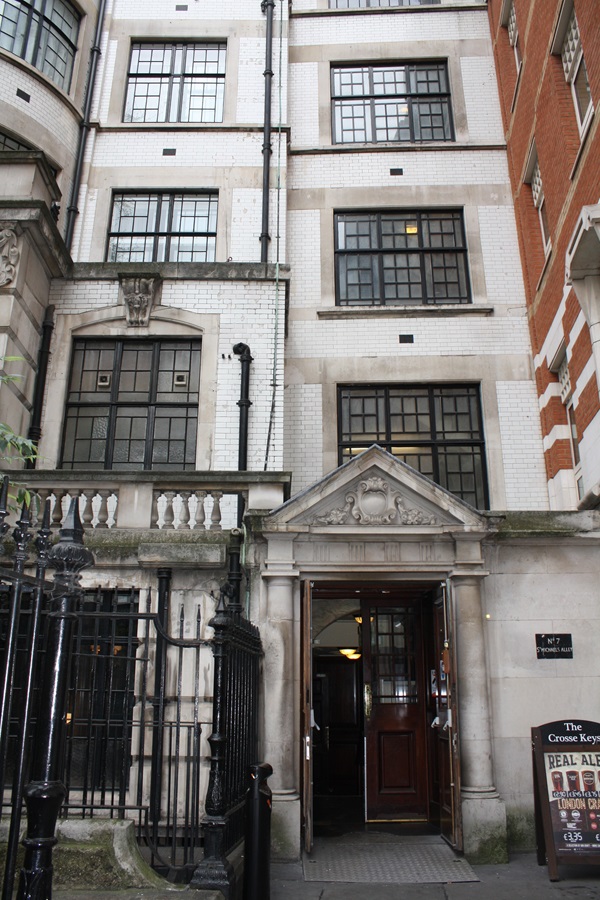
External photograph of the building – main entrance.
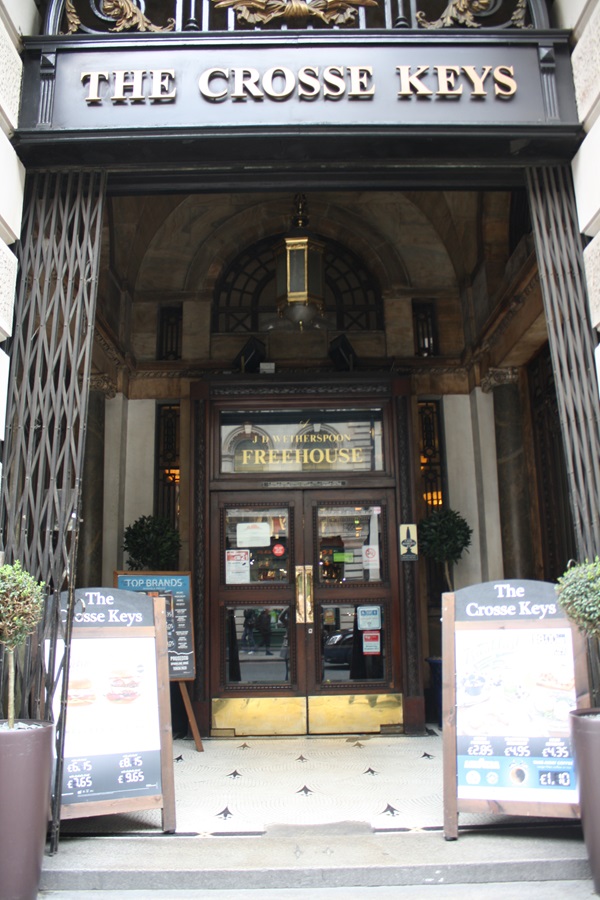
Extract from Wetherspoon News Winter 2018.
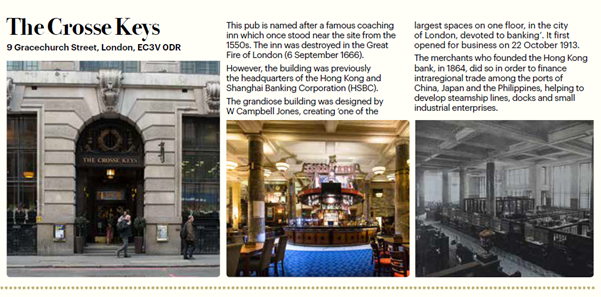
If you have information on the history of this pub, then we’d like you to share it with us. Please e-mail all information to: pubhistories@jdwetherspoon.co.uk